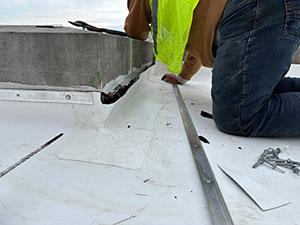
A single-ply roofing system is one comprising one flexible membrane sheet of material. Usually made of synthetic materials such as ethylene propylene diene monomer, thermoplastic polyolefin, or polyvinyl chloride, this membrane is supposed to provide flat or low-sloped roofs with a long-lasting, waterproof covering.
Popular for commercial, industrial, and residential buildings, single-ply roofing systems are fast and easy to install. Call Century Commercial Roofing in Barberton, OH on 330-926-6972 to book a consultation.
What is Single-Ply Roofing?
Single-ply roofing systems, whether flat or low-sloped, depend on one layer of flexible synthetic or thermoset membrane to provide waterproofing and durability. Mostly TPO and PVC make up these membranes. TPO, UV-resistant and flexible, made of polypropylene and ethylene-propylene rubber, is a good roofing material as thermoplastic polymer PVC resists UV radiation, chemicals, and fire. Installation consists in fastening big membrane sheets to the roof deck via mechanical, adhesive, or heat-welding seams. This technique creates a continuous water barrier, therefore extending the lifetime of the roof.
Since they are environmentally resistant, robust, and quick to install, single-ply roofing systems provide a flexible, efficient, and sustainable building protection solution for many building projects.
Why Install Single-Ply Roofing?

The advantages of singly-ply roofing are:
- Light Weight: Single-ply membranes are lighter than more traditional built-up roofing systems. This function reduces building construction load and simplifies the installation process.
- Easy Installation: Single-ply roofing installs faster and needs less work than other roofing materials. Made either mechanically joined, heat-welded together, or easily bonded onto, large rolls or sheets of the membranes are made.
- Durability: Single-ply membranes are made to be robust against UV radiation, rips, and punctures as well as to withstand elements of nature. They can resist harsh temperatures, strong winds, and hail among other weather events.
- Flexibility: Without sacrificing their integrity, these roofing systems can allow building movement and settling. This adaptability helps to avoid leaks and cracks over time.
- Low maintenance: Demand little maintenance. Although routine inspections and repairs could be required to guarantee long-term performance, maintenance expenses are frequently less than those of other roofing materials.
- Versatility: Single-ply roofing provides versatility in selecting a membrane that best fits the particular needs of the building and climate conditions by being available in several materials like EPDM, TPO, and PVC.
Conclusion
Overall, single-ply roofing systems are a reliable choice for flat and low-sloped roofs due to their energy efficiency, durability, and ease of installation. Their light weight reduces structural load; EPDM, TPO, and PVC are weatherproof and flexible. Reflective membranes reduce cooling demand, saving electricity.
Single-ply roofs are low-maintenance, recyclable, and affordable for various building needs. These systems continue to preserve buildings and promote environmental responsibility and long-term performance in commercial and residential settings. To book a consultation call Century Commercial Roofing in Barberton, OH on 330-926-6972.
